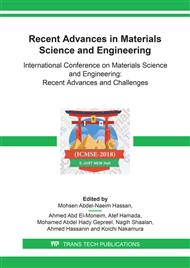[1]
H. Bikas, P. Stavropoulos, G. Chryssolouris. Additive manufacturing methods and modelling approaches: a critical review, International Journal of Advanced Manufacturing Technology 83 (2016) 389–405. https://doi.org/10.1007/s00170-015-7576-2.
DOI: 10.1007/s00170-015-7576-2
Google Scholar
[2]
Wei Gao, Yunbo Zhang, Devarajan Ramanujan, Karthik Ramani, Yong Chen, Christopher B. Williams, Charlie C.L. Wang, Yung C. Shin, Song Zhang, Pablo D. Zavattieri, The status, challenges, and future of additive manufacturing in engineering, Computer-Aided Design 69 (2015).
DOI: 10.1016/j.cad.2015.04.001
Google Scholar
[3]
Syed A.M. Tofail, Elias P. Koumoulos, Amit Bandyopadhyay, Susmita Bose, Lisa O'Donoghue, Costas Charitidis, Additive manufacturing: scientific and technological challenges, market uptake and opportunities, Materials Today 21 (2018).
DOI: 10.1016/j.mattod.2017.07.001
Google Scholar
[4]
Mary Kathryn Thompson, Giovanni Moroni, Tom Vaneker, Georges Fadel, R. Ian Campbell, Ian Gibson, Alain Bernard, Joachim Schulz, Patricia Graf, Bhrigu Ahuja, Filomeno Martina, Design for Additive Manufacturing: Trends, opportunities, considerations, and constraints. CIRP Annals - Manufacturing Technology 65 (2016).
DOI: 10.1016/j.cirp.2016.05.004
Google Scholar
[5]
Yunlong Tang Yaoyao Fiona Zhao, A survey of the design methods for additive manufacturing to improve functional performance, Rapid Prototyping Journal 22 (2016) 569-590. http://dx.doi.org/10.1108/RPJ-01-2015-0011.
DOI: 10.1108/rpj-01-2015-0011
Google Scholar
[6]
Germain Sossou, Frédéric Demoly, Ghislain Montavon, Samuel Gomes, An additive manufacturing oriented design approach to mechanical assemblies, Journal of Computational Design and Engineering 5 (2018).
DOI: 10.1016/j.jcde.2017.11.005
Google Scholar
[7]
Martin Leary, Luigi Merli, Federico Torti, Maciej Mazur, Milan Brandt, Optimal topology for additive manufacture: A method for enabling additive manufacture of support-free optimal structures, Materials & Design 63 (2014).
DOI: 10.1016/j.matdes.2014.06.015
Google Scholar
[8]
Jun Wu, Charlie C.L. Wang, Xiaoting Zhang, Rüdiger Westermann, Self-supporting rhombic infill structures for additive manufacturing, Computer-Aided Design 80 (2016) 32-42. https://doi.org/10.1016/j.cad.2016.07.006.
DOI: 10.1016/j.cad.2016.07.006
Google Scholar
[9]
Xu Guo, Jianhua Zhou, Weisheng Zhang, Zongliang Du, Chang Liu, Ying Liu, Self-supporting structure design in additive manufacturing through explicit topology optimization, Computer Methods in Applied Mechanics and Engineering 323 (2017).
DOI: 10.1016/j.cma.2017.05.003
Google Scholar
[10]
Remi Ponche n , Olivier Kerbrat, Pascal Mognol, Jean-Yves Hascoet, A novel methodology of design for Additive Manufacturing applied to Additive Laser Manufacturing process, Robotics and Computer-Integrated Manufacturing 30 (2014).
DOI: 10.1016/j.rcim.2013.12.001
Google Scholar
[11]
Jikai Liu, Albert C. To, Deposition path planning-integrated structural topology optimization for 3D additive manufacturing subject to self-support constraint, Computer-Aided Design 91 (2017) 27-45. https://doi.org/10.1016/j.cad.2017.05.003.
DOI: 10.1016/j.cad.2017.05.003
Google Scholar
[12]
Nicolas Gardan, Alexandre Schneider, Topological optimization of internal patterns and support in additive manufacturing, Journal of Manufacturing Systems 37 (2015) 417-425. https://doi.org/10.1016/j.jmsy.2014.07.003.
DOI: 10.1016/j.jmsy.2014.07.003
Google Scholar
[13]
Weihong Zhang, Lu Zhou, Topology optimization of self-supporting structures with polygon features for additive manufacturing, Computer Methods in Applied Mechanics and Engineering 334 (2018) 56-78. https://doi.org/10.1016/j.cma.2018.01.037.
DOI: 10.1016/j.cma.2018.01.037
Google Scholar
[14]
Shutian Liu, Quhao Li, Junhuan Liu, Wenjiong Chen, Yongcun Zhang, Realization Method for Transforming Topology Optimization Design to Additive Manufacturing Structures, Engineering (2018) https://doi.org/10.1016/j.eng.2017.09.002.
DOI: 10.1016/j.eng.2017.09.002
Google Scholar
[15]
G. Allaire, C. Dapogny, R. Estevez, A. Faure, G. Michailidis, Structural optimization under overhang constraints imposed by additive manufacturing technologies, Journal of Computational Physics 351 (2017).
DOI: 10.1016/j.jcp.2017.09.041
Google Scholar
[16]
Amir M. Mirzendehdel, Krishnan Suresh, Support structure constrained topology optimization for additive manufacturing, Computer-Aided Design 81 (2016) 1-13. https://doi.org/10.1016/j.cad.2016.08.006.
DOI: 10.1016/j.cad.2016.08.006
Google Scholar
[17]
Matthijs Langelaar, Topology optimization of 3D self-supporting structures for additive manufacturing, Additive Manufacturing 12 (2016) 60-70. https://doi.org/10.1016/j.addma.2016.06.010.
DOI: 10.1016/j.addma.2016.06.010
Google Scholar
[18]
Ratnadeep Paul, Sam Anand, Optimization of layered manufacturing process for reducing form errors with minimal support structures, Journal of Manufacturing Systems 36 (2015) 231-243. https://doi.org/10.1016/j.jmsy.2014.06.014.
DOI: 10.1016/j.jmsy.2014.06.014
Google Scholar
[19]
Jun Wu, Anders Clausen, Ole Sigmund, Minimum compliance topology optimization of shell–infill composites for additive manufacturing, Computer Methods in Applied Mechanics and Engineering 326 (2017).
DOI: 10.1016/j.cma.2017.08.018
Google Scholar
[20]
Yiqiang Wang, Lei Zhang, Stephen Daynes, Hongying Zhang, Stefanie Feih, Michael Yu Wang, Design of graded lattice structure with optimized mesostructures for additive manufacturing, Materials & Design 142 (2018).
DOI: 10.1016/j.matdes.2018.01.011
Google Scholar
[21]
Ajit Panesar, Meisam Abdi, Duncan Hickman, Ian Ashcroft, Strategies for functionally graded lattice structures derived using topology optimisation for Additive Manufacturing, Additive Manufacturing 19 (2018).
DOI: 10.1016/j.addma.2017.11.008
Google Scholar
[22]
K. Mäntyjärvi, T. Iso-Junno, H. Niemi, J. Mäkikangas, Design for additive manufacturing in extended DFMA process, Proceedings of the International Conference on Materials Science and Engineering ICMSE-RAC 2018, (2018).
DOI: 10.4028/www.scientific.net/kem.786.342
Google Scholar


